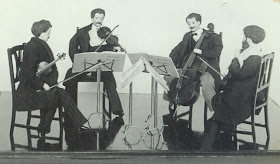One
hundred years ago, on February 21, 1914, Frances Glessner Lee presented her
model of the Flonzaley Quartet to that world-famous string quartet. Known for her earlier model of the Chicago
Symphony Orchestra and later for her meticulously crafted series of “Nutshell
Studies of Unexplained Death,” Frances Glessner Lee spent nearly two years
creating the quartet model.
Her son,
John Glessner Lee, recounted the creation and presentation of the model in his
1971 book, Family Reunion, and we
present that excerpt in its entirety. (Notes: He refers to his mother as FGL; their family
home where the model was created and unveiled was located at 1700 S. Prairie
Avenue, one block north of the Glessner House).
“(The
Chicago Symphony Orchestra model) really launched FGL in her career of model
work. Her next model was the Flonzaley
Quartet – perhaps the best-known string quartet of the era – and a masterpiece
it was. It took nearly two years to
do. It really was precise, the
individuals were striking likenesses, and everything about it was as close to
reality as one could get. You could
actually play the ‘cello – it emitted a faint squeak, but no sound would come
from the smaller instruments, despite the care in making the bridge and strings
and other parts. By the time FGL got
going on the Quartet I was old enough to help.
We went to concerts together, and sat on opposite sides of the house,
and made elaborate notes on how the men sat and what they wore – Mr. Betti’s
vest (he was the first violin) – how Mr. Pochon put his feet (he was the second
violin) – d’Archambeau’s gold watch chain, how it hung (he, the cellist) and last,
but by no means least, Ugo Ara, who played the viola, a little Italian man with
a magnificent Assyrian beard, how he managed his viola amongst the profusion of
shrubbery.
FGL
presented the model to the Quartet one evening at dinner at our house in Chicago. It was covered with a large floral piece in
the center of the table, which gave no hint as to what was underneath. FGL sat at one side of the table which was
long and narrow and my grandfather opposite her, each with a member of the
Quartet on both sides of them. We lesser
lights were farther down the table.
After dinner, the floral piece was removed with a flourish, and there, not
two feet from their noses, was this model of themselves playing! The effect was extraordinary. For a moment nobody spoke, and then all four
members of the Quartet burst out into voluble language. Nobody listened. But each one of them pointed with delight to
the eccentricities of the other three. I
still remember Mr. Betti, with a magnifying glass, peering over the shoulder of
his own miniature, trying to read the music on the music rack. It had been specially written by Frederick
Stock, the conductor of the Chicago Symphony, in the style of Schoenberg, but
was impossible to play – a fact which Mr. Betti soon appreciated.
Then my
grandfather read a long account of how the model was made, which FGL had
written. The figures were Viennese
dolls, as before, modified by FGL to incorporate a wire frame so they would
hold a position. The heads were modeled
out of a mixture of LePage’s fish glue and plaster of Paris which she had
developed. This was long before the days
of plastics or quick-drying cement. The
result, which took several days to dry, became as hard as glass. To this cotton fibers were added for hair,
and the result painted to match the individual.
I can still remember the four little heads hanging upside down on a
stand on FGL’s work table. Mr. Ara’s
with its square cut beard was particularly gruesome, and one had uncomfortable
thoughts of the guillotine. The
accompanying picture of FGL shows her working on this model at a card table in
her bedroom in Chicago.
The model
was built for permanence, with every party thoroughly anchored. When I last heard of it, the Quartet had
taken it to Switzerland and placed it in a museum near the home of Mr. (Edward J.) de Coppet, the chief sponsor of the Quartet.
Mr. Pochon told us afterwards that the only damage resulting from the
long voyage was that his bow had slipped off of his violin, which they had been
able to fix themselves.”
The presentation
was also recorded in the Glessner journal, by this time being written by John
Glessner. He notes that in addition to
the persons listed above, those attending the dinner included his wife,
Frederick Stock and his wife, Enrico Tramonti (CSO harpist) and his wife, and
Henry Voegeli (CSO assistant manager and treasurer) and his wife. An interesting discrepancy in the two
accounts is that John Glessner Lee places his grandfather in a place of honor
with members of the Quartet to either side; but John Glessner clearly indicates
it was his grandson, age 15 at the time, who sat opposite his mother:
“John Lee
sat opposite his mother at table & did his part very well. Betti seated at right & Pochon at Frances’
left, d’Archambeau at right & Ara at John’s left. Next to Betti came Mrs. Tramonti, then I, Mr.
Stock, Mrs. Voegeli, Ara, John, d’Archambeau, Frances, Tramonti, Voegeli, Mrs.
Stock, Pochon & Frances Lee.”
One must
conclude that John Glessner’s account, written immediately after the event is
indeed accurate, especially since he identifies where each of the 14 members of
the party sat. Why John Glessner Lee saw
his grandfather in that place of honor and not himself when recounting the
incident nearly 60 years later remains an interesting question, but perhaps shows
the high level of esteem in which he held the patriarch of the family.


No comments:
Post a Comment